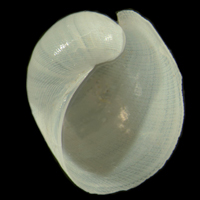|
< Previous family introduction |
|
|||||
 |
Family Philinidae Philinids
|
|||||
|
Philinids are large-bodied, lozenge-shaped head-shield slugs that completely enclose a thin, fragile, internal shell in the rear half of the body beneath the posterior shield. The shell has a broad aperture and a low spire, or no spire at all. The family occurs worldwide in shallow and deep water on soft substrates; shells range in size from 2 to 40 mm in length. Most philinids live infaunally in fine sandy or muddy habitats, but a few are epifaunal. The most common and by far the largest NSW species, Philine angasi, lives intertidally and subtidally burrowing in fine silty sand. The infaunal animals are usually white while the epifaunal species may be brightly coloured. The diet of philinids is frequently small bivalves. The animal has a radula as well as three hard gastral plates in the stomach, used for crushing and grinding the food. In NSW three species are recorded. As well as the large, common Philine angasi there are two much smaller species, one with a shell of only 2 mm long, the other twice that size. One of these occurs intertidally and in the shallow subtidal, but the other is known from dredgings from 15-200 m. Family Reference Burn (2015) figured the most common species in Victoria. Rudman (1972) reported in detail on the anatomy of the genus. Coverage As well as the three species detailed here, there are three other species of the family recorded from NSW in old records:
The following additional species was reported as observed in northern NSW by Nimbs & Smith, 2017:
Identification Notes Shells are thin and fragile, with the aperture occupying at least three-quarters of the ventral surface.
|